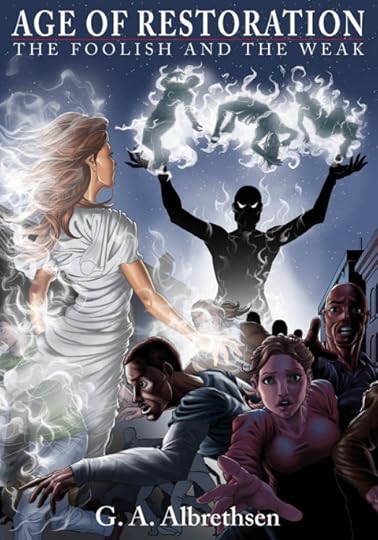G.A. Albrethsen's Blog: Age of Restoration, page 10
February 22, 2012
Three topics on self-publishing you should read
If you’re a self-published author, I’ve been reading a lot of your blog posts lately. I’m new to this side of publishing, and so I’m trying to familiarize myself with the territory. In order to do that, I’ve been following the short URLs in tweets to read what many of you are thinking about. Here are three posts that I’ve read in the last few days.
SHOULD AMAZON CHARGE TO UPLOAD BOOKS?
Apparently, there’s been some discussion regarding Amazon actually charging authors to upload their books. I guess this would be in addition to the file delivery fee (10 cents of every book, in my case), and the royalty fee (3o percent, again, in my case).
The two posts I’ve read on this subject, started by Rob Guthrie at robonwriting.com (he has an initial post under Phreaky Friday, and then another post with responses by fellow authors) and followed up by Trish Gentry at chickletslit.wordpress.com, have both been in favor of some kind of upload charge. Guthrie gives $500 per book as an example. This would be good for serious authors, the bloggers contend, because it would do a couple of things. One, it would help to reduce the number of free or 99 cent books available on Amazon—assuming Amazon charged to upload the freebies and the discounted books— and two, it would slow down those would-be authors (who do little editing or have little writing talent) from uploading their dreck. It’s win-win for readers and authors—less trash to wade through for readers, and less trash being passed off as competition for good writers.
If you read an earlier post of mine on this site, you know I’m not in favor of giving away books for free, even in the KDP Select promotion. I don’t want my readers to get used to getting my books for free, because it does skew the perception of value. I believe in my book enough to charge for it, albeit what’s become the top-end price ($2.99) for debut authors.
I don’t feel like Amazon owes me any opportunities to upload my book for free, and I feel they have every right to take something from the sale of each book. That’s become an industry standard. I’d rather keep my expenses down as much as I can, however, so I’m not going to go out of my way to favor or encourage an upload fee. If it happens, I hope it will be the way Guthrie and Gentry describe.
STORY BEFORE PERFECTION
Another post, on a totally different subject, also caught my interest this week. It comes from Jody Hedlund at jodyhedlund.blogspot.com and is entitled Publication: Perfection Not Required.
Hedlund makes very good points here. We all want our books to be as perfect as they can be, but not at the expense of the story. The storyteller in me says, “Woohoo! Darn straight!” The editor in me goes, “Now, hold on, just a minute.” Readers don’t want grammatical errors or misspelled words, but they do want some pizzazz and literary flair. And they do want a story that doesn’t follow convention, at least not that they can tell. They want something fresh, something new, and some style along with their substance.
For me, character dialogue is one thing that should not be perfected—it’s been a long time since our speech has matched our writing style (okay, with Twitter and other social media, maybe the writing has degraded to how we speak). If the character speaks a certain way, then that character should speak that way, and do so throughout.
WATCH OUT FOR EDITORIAL REVIEWS
Last post I wanted to share was this one from Jeff Bennington, at The Writing Bomb. It’s called Amazon is Publishing Reviews? Will You be Next? Bennington brings up the point that places like Publishers Weekly can get a review of your book into the Editorial Review section of your book’s page, which comes above the Book Description. It’s awesome if it’s a great review, but not so great if it’s not, because it can push everything else we want our potential readers to see down the page, thus souring the customer’s attention completely, even if actual customer reviews are awesome.
We all know there’s a difference between what professional critics see and what the average reader sees. As argued by Hedlund above, perfection should not trump story. If that’s what the professional reviewer is hung up on, I think there’s a problem.
The scariest thing about this is, the author has no control over where the reviews show up, so beware, if you have sent your book off for review somewhere else. There’s a chance the review, for good or bad, might end up there.
Anyway, thought I’d comment on these posts with one of my own, since it would take about 100 tweets to get what I had in here out.
Shoutouts to @KirkusMacGowan, @RachelleGardner and @Kindlbookreview for tweeting or retweeting these blog posts.








February 20, 2012
The making of “Who is … Paz Kirkegaard?” “The Foolish and the Weak” book trailer, Part I

Dominique Razon as Paz Kirkegaard in "The Foolish and the Weak" book trailer entitled, "Who is ... Paz Kirekgaard?"
Back in August of last year, the editing of “The Foolish and the Weak,” the first book of my Age of Restoration series, was in full swing. I was hoping for a September publication date (oh, silly me!) and, therefore, wanted to get the ball rolling on a book cover and a book trailer.
The book cover was obvious—couldn’t have a book without it! The trailer, however, was not as necessary, but it was one more way to promote the book. Book trailers have become a popular thing, as of late, even if it’s still up in the air whether or not they really sell books. In my mind, it was worth the try, and as it is, no form of advertising was ever a guarantee.
Guru.com became the go-to place for both. The search for a freelance artist for the book cover began on August 5. The one for the book trailer began on August 17. The book cover went through its 10-day bidding process and was eventually awarded and work began on that project.
The trailer bidding, on the other hand, closed early. Only five freelancers bid the job. Four of them were around or way below the asking price, while a fifth was considerably above. In looking at what the four proposed, it was obvious they weren’t bidding based on the details of the project.
What followed then was a long conversation, over a period of months, with the fifth bidder. It became readily apparent that what was proposed for the trailer on my part through Aevea Publishing wasn’t going to fit in the proposed budget. Looking back, I can smile, but at the time, I confess to a significant level of frustration.
It was like the conundrum Bill and Ted found themselves in at the beginning of Bill & Ted’s Excellent Adventure. They needed Eddie Van Halen in order to have an excellent video, but to get Eddie Van Halen, they first needed the excellent video. In the case of the book trailer, in order to justify spending money on it, especially more money, we needed to know if the trailer would actually equate to book sales. Unfortunately, the only way to find out was to make the trailer, and not knowing if it would lead to sales or not, there was little desire to go over budget.
The decision was made to go with the fifth freelancer, but the guru.com project was closed until the details of the trailer could be finalized. What ensued over the next two months, from late August to late October, was a conversation that felt more like a tug-of-war at times, between keeping under budget—while having something to grab viewers’ attention—and still staying true to the book.
Scripts were passed back and forth, portions of the book were sent to give the production company a taste of what was sought, and finally, the concept of a script was settled upon. It was decided, due to budget constraints, that the live action book trailer would star one actress (to play the main character, Paz Kirkegaard), it would take place completely indoors, and would be filmed at night.
Instant messaging would take place between Paz and her mother, Paloma, until said IM was hijacked by some mysterious interloper who had access to an unseen camera. The messaging in the chat would hint at changes taking place in Paz. Once the chat was taken over by the unknown entity, there would be some sort of manifestation of at least one of the changes Paz was undergoing.
The project reopened on Guru in late October, but the search for the actress, while well under way, had not been finalized. The script still needed some work, too, but finally, another milestone was reached in mid-December, when essentially all of the needed pieces began to fit into place. The only thing that was off then, was timing. Eventually, Christmas got in the way, and so the shoot was tentatively proposed for the first weekend in January. That ended up being moved to the following weekend.
Shooting the trailer the second weekend actually got moved a day, too, because the actress, , was simultaneously being chosen for a commercial which rearranged her schedule. Finally, there were no more scheduling conflicts and filming commenced at 4 pm, Sunday, January 15.
More in Part II.








February 15, 2012
Where the storytelling begins: The book cover

What do you see? I see the story being told ...
What’s the purpose of a book cover?
We’re told we need to have a great book cover, because that’s the first thing potential customers will see. The quality of the book cover—it’s “wow” factor—will compel them to click on the book’s web page, where we then must have a great description, great reviews, and whatever other great things we can cram there so as to entice the customers to buy the book.
Just what constitutes a great book cover? In general terms, it’s whatever grabs the attention of readers over a myriad of other book covers they’re scrolling through. It must stand out, draw them in, and make them want to know more about what’s inside.
How that all happens is still pretty subjective. I know what I might find to be interesting isn’t necessarily going to be what interests someone else.
In my case, when it came time to determine what to do with the book cover, I went about it in the same way as I wrote the book. I wanted it to be something that would catch my own attention. But beyond that, I wanted it to start telling the story before anyone ever looked at the sample chapters or decided to buy the book.
I think the cover accomplishes that. The more you look at it, obviously, the more you see, but at first glance, what I want you to know is that inside, the story will involve two beings with extraordinary abilities. One appears to be angelic, or perhaps ghost-like, while the other is shrouded in darkness. Their identities are purposefully enigmatic.
By the people in the foreground, specifically the fact that they’re running away, and with varying expressions of concern on their faces, I want you to know there’s something frightening or menacing going on. I am also trying to tell you that this tale takes place in contemporary times, based on the little bit of the buildings you can see, but primarily by the way people are dressed.
Then, if you want to dig a little deeper, there are a few more things I’m trying to tell you. The crowd is kind of diverse, and one of the people, in the lower left corner, seems to be passing through the woman in white.
I chose this particular style, kind of like a comic book, because the book is meant for pre-teens and teens. While I haven’t bought a comic book in years, I’m still a fan, and I also thought that with all the superhero movies out, a comic book-looking cover would be appealing to the younger audience.
Those are the ideas behind The Foolish and the Weak book cover.
Oh, one more little tidbit. A reader need not go much further than the opening paragraphs in the prologue to find out what the book cover is all about, so it literally leads the story off. However, in addition to being the beginning, the cover also represents a pivotal part near the end of the book, too.
And, of course, not all is as it seems on the cover! Maybe I’ll tell you why someday. Or you could just read the book …








February 13, 2012
First they came for my mashed potatoes …

They're tasty, I'm sure. Photo from thedailygreen.com
Look.
There’s an obesity issue in the United States. It crosses all lines—gender, race, age, economic status, etc. We need not look further than our own mirrors in too many cases.
I, for one, have at least 40 lbs. to lose again (done it twice, gained it all back). I could probably stand to lose 60-70 lbs. That would put me back to the weight I was in high school.
First Lady Michelle Obama unveiled her “Let’s Move” campaign a couple of years ago, aimed primarily at childhood obesity. Last week, however, it was announced that the military will be revamping its menu selections, too, and Mrs. Obama was at the Little Rock Air Force Base to cheer on the decision.
First ladies have traditionally championed some cause. That’s fine.
And government-funded departments, agencies and programs are always at the whim and mercy of whoever is in office. This week, it’s more fruits and vegetables for the military. Next time, it might be gruel for the peasants.
If I were to ask an active duty military person what they thought about the new menu rules, I doubt I’d get a straight answer. They don’t badmouth their superiors. There’s a loyalty there, something to be admired, and having healthier choices on the menu is not on the same level as withdrawing funding from the military or withholding moral support.
Yet, to me, it’s just one more thing the government has done to take away choice, responsibility and consequence.
We won’t eat healthy, that leads to health problems, and that leads to expensive health care.
Something the government doesn’t need since parts of the national health care bill have been phasing in since it was passed and will come into full force in 2014.
Ergo, the government must step in and save us from ourselves.
I’ve heard many ask the question, where does it end? The answer is, it doesn’t, at least not before we’re all looking at a “The Day After Tomorrow” scenario, except it’s not Mother Nature that will do it to us. It will be ourselves.
I don’t mind reminders. If restaurants want to provide healthier alternatives on their menus, okay. Even stating the calories of each menu is okay.
It’s the compulsion part I take issue with.
Liberty is a fundamental right, and not just in our Representative Republic. It is a God-given right. It doesn’t come from government. It’s supposed to be protected by government. Not usurped, or nudged, or poked, or prodded from us.
So, while this is going on, there’s also the Obama Administration’s decree that any organization that receives government funding must provide free contraceptive options in their health care packages. Essentially, that’s been boiled down to Catholic-run entities paying for the programs, since they’re the ones revolting the loudest. However, it’s much more than that.
It’s yet another encroachment.
Sure, President Obama is now saying he’ll back off. He’s providing some alternative, trying to be reasonable, when the whole concept from beginning to end is unreasonable. If he actually does offer the choice. But that’s how they do it, too. False choices, false premises. Control the argument, control the masses.
Looks like the Catholic bishops are having no part of it. Lines are being drawn in the sand.
The answer is that we take responsibility for own selves, and then suffer the consequences. Pure and simple. It’s hard, yes, when innocents are in the mix. Government isn’t the end-all, though, and it never will be.
Getting back on the treadmill before I’m forced to eat my brussel sprouts.











